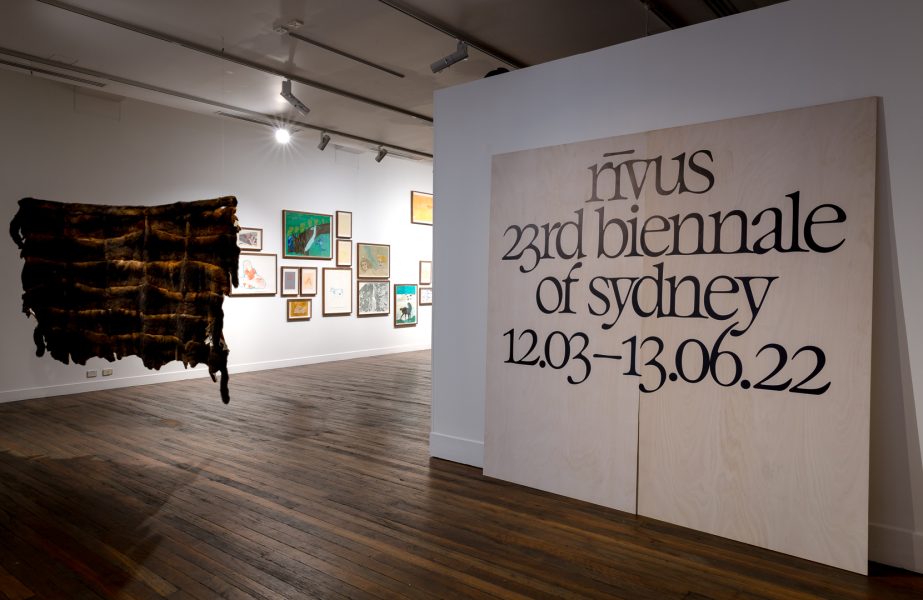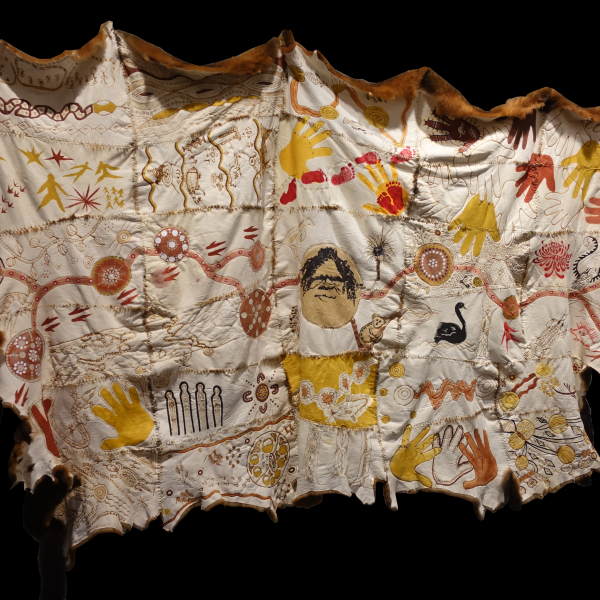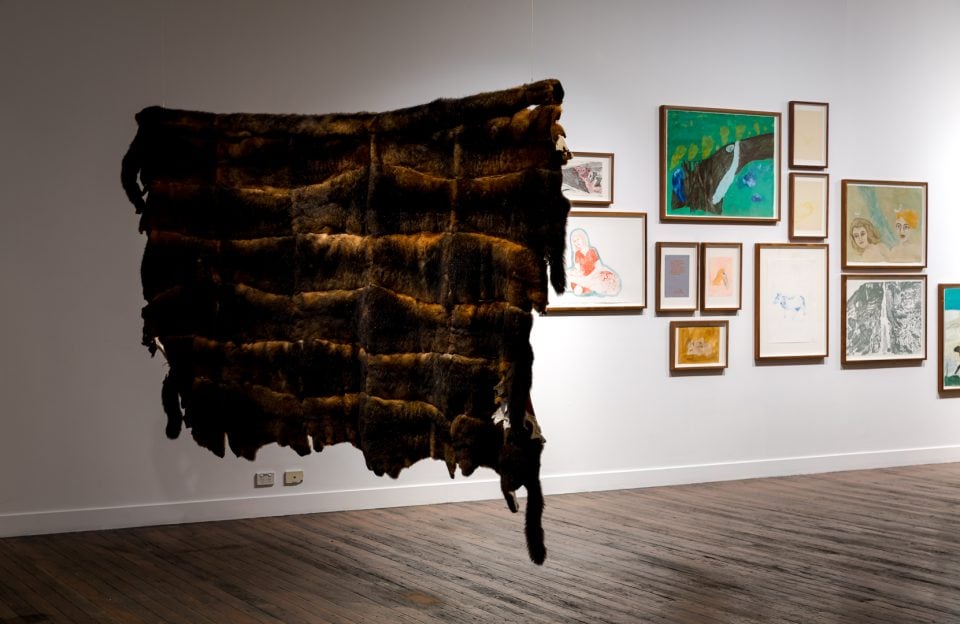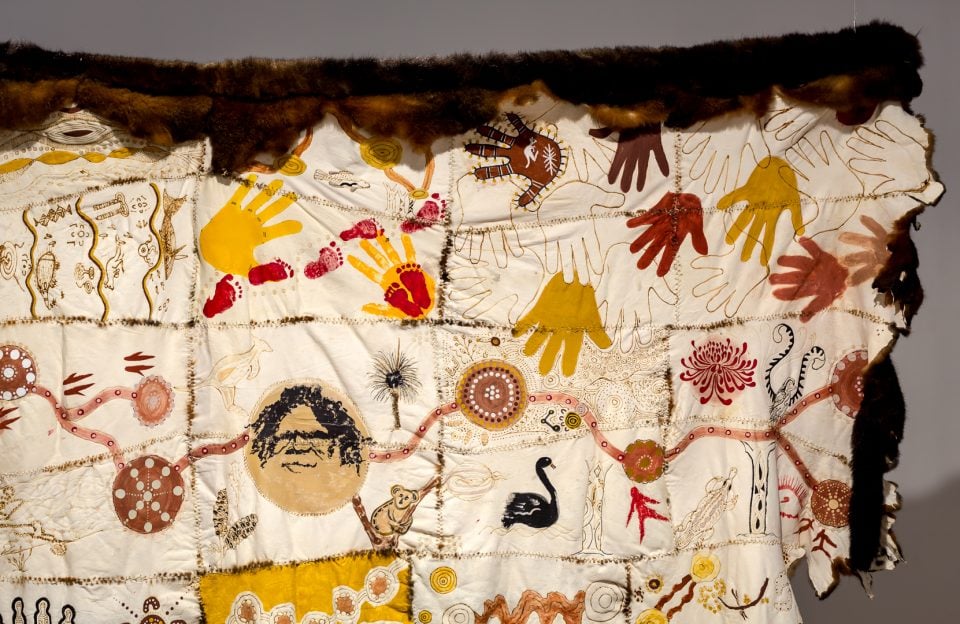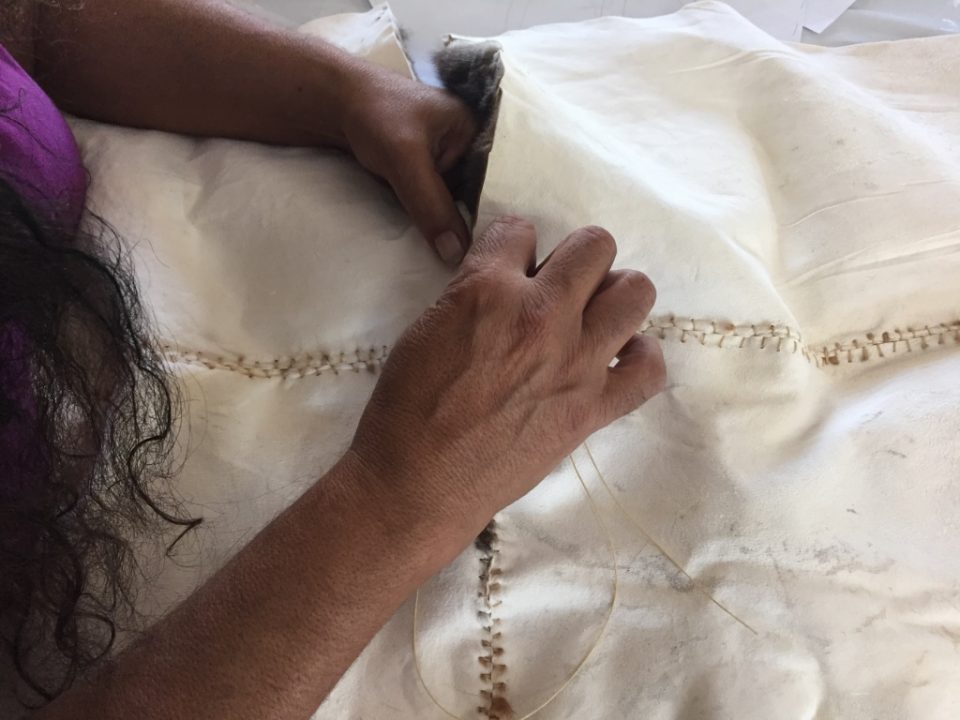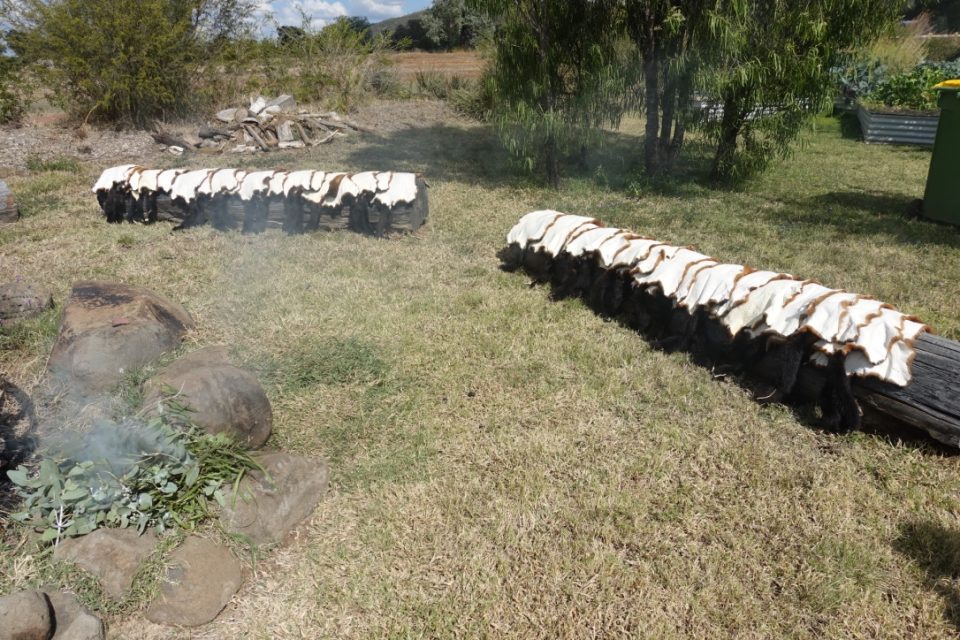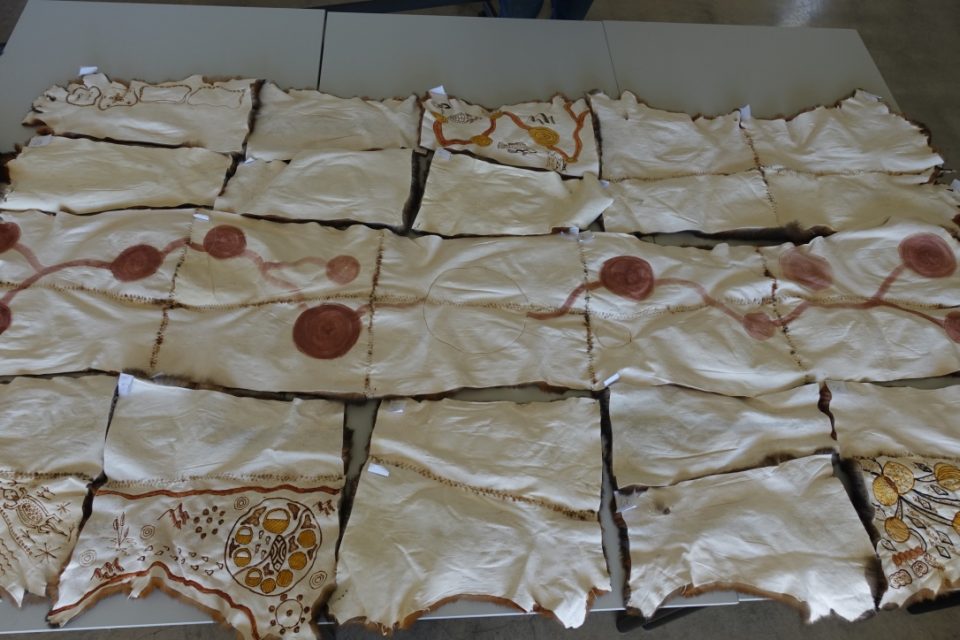Myall Creek Gathering Cloak Stories
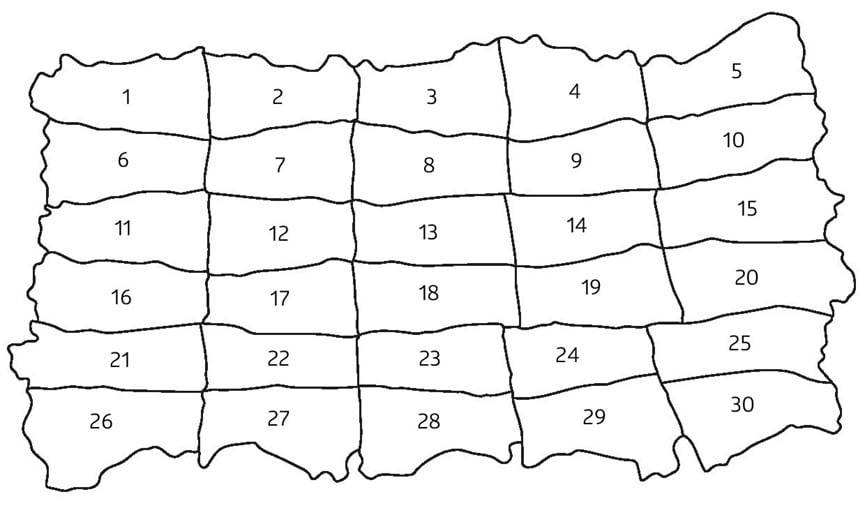
1
Adele Chapman-Burgess
Ngarrabul/ Gamilaraay
“Ngay Dhiiyaan” (My Family).
The wadhaagudjaaylawan (birth spirit) blessed me with maa (five) beautiful gaaynggal (babies). First there were just the two of us, then we were blessed, our maa came along, we became a dhiiyaan (family) of guulay (seven).
The snake is a topographic view of the Beardy River of my country in the New England Highland, Glen Innes, NSW. This snake also represents the journey we have taken together as a dhiiyaan. It has many twists and turns, just like life…
“Difficult roads often lead to beautiful Destinations”.
2
Gamilaroi/Ngarrabul
This artwork represents the rivers, creeks, waterholes and the river rocks of our country and all of Guunii (Mother) earth.
They were and are still extremely vital to the spiritual and physical well being of our sacred lands, our Elders and to us today.
3
Jack Chapman-Burgess
Ngarrabul/ Gamilaraay
Depicts a fishing trip two mates take annually canoeing down a local water system. The story starts with my friend Harry and I sitting and planning out the trip. Each circle represents the major water holes we camp at, connected by running water. The fish are catfish (top left) and eastern cod (bottom right), which are native to the system. Rain falls at one of the holes because at this hole the rain forest reaches down from the mountains and touches the edge of the water. A mountain sits above the biggest waterhole and is shown in this story.
4, 5, 9, 10
Friends of Myall Creek Memorial Committee 2017/18
John Addley, Cecilia Blackwell, Adam Blakestar, John Brown, Kelvin Brown,
Adele Chapman-Burgess, Graeme Cordiner, Anne Daly, Brian Donnelly,
Colin Isaacs, Marilyn Isaacs, Jo Miller, Keith Munro, Ivan Roberts, Janelle Speed, Peter Stewart, and Carmen Southwell.
6
Diane Marlow
Wonnarua
Side Drawing; This is my tribal totem the wedge-tailed eagle. The water hole and gathering designs symbolise my grandfather being born on the riverbanks. I use my totem in my works to help me with connection to my ancestors.
Main Panel: These are some of the many rock paintings of the Gameroi/Ngarrabul/Banbai/Anaiwan Country.
7
Colin Isaacs
Dharawal/ Noongar
I am a Dharawul man and this is my journey from Sydney to Ngarrabul country. The design includes extended family and I am the white wallaby and my wife Marilyn is the bush turkey.
8
Indi Chapman-Burgess, Alex (waaruu) Watters and Louis Chapman-Burgess
Ngarrabul
A mothers love for her child is like having your heart on the outside…
Someone you love like no other, yet you can never fully understand.
‘Surprisingly unconditional LOVE makes the journey to your heart’
11
Adele Chapman-Burgess
Gomeroi Boobera Lagoon story
As the resting place of this ancestral spirit (The Kurrea) the Lagoon is a place of tremendous cultural and spiritual significance. A place of healing.
11, 12, 13, 15 – 20
Songlines
Featuring through the centre of the cloak is a collaborative image and story of our Songlines. The designs on the skins link communities and shared path ways around Myall Creek from Bogabilla, Moree, Warialda, Delungra, Bingara, Myall Creek, Inverell, Tingha, Guyra and Glen Innes.
14
Vicki Duncan
Gomeroi/ Bigumbul/ Kwiambal
My design is of emu, carpet snake, bush food, goanna and the hills of Ashford, Kwiambul area.
Kwiambul people were massacred at Myall Creek and the dots are our people, the star is for our loss. Included is the junction of the Macintyre and Severn Rivers, scar trees, large rocks, native grass and grubs which were a source of food. Is a long way from Ashford to Bingara.
Remembering the way it was.
21
Steve Widders
Gamilaroi/Wirrayaraay/Anaiwan
I am a descendent of the Wirrayaraay people and the Anaiwan from the Terry Hie Hie area.
The goanna is Mum’s Wirrayaraay totem and the echidna is my Anaiwan totem. The totem in the middle symbolise the two language groups coming together. The strong social and cultural connections of today are from those of yesterday.
22
Andrea Chapman, Kylie Chapman, Adele Chapman, Avril Chapman
Ngarrabul/ Gamilaraay
“Baawaa’s Gatherings”
Our Artwork represents the four of us baawaas (sisters) who grew close in a sharing environment. After adulthood we found many times to come together to share our lives and children. Camping trips were very special times to get together to share and yarn.
23
A Ngarrabul children’s tale
Camping on the Boyd River down the old Grafton Road for many school holidays were the highlights of our summers.
The artwork tells the story of the catfish (gay gay) rings or nests. We were told by the Elders that fishing was not permitted whilst the rings and fish were visible. As children we didn’t understand this but today we can recognise the importance of that rule. In those days these rings could be seen in many rivers in great numbers, however these days we are lucky to find one to show our jarjums (children).
24
Beryl Hepi (Connors)
Jukimbul
The waterholes at Goonoonwigal, The Gully, were important for us. We used yolks across our shoulders to carry our water – full bottles and buckets of water to our homes. We knew where all the waterholes were and when the closest waterholes dried up we had to walk many miles into the bush to collect our fresh water. It was mainly a girl’s job as the boys were sent out to work on local properties.
25
Elizabeth Connors, Linda Connors, Barbara Connors
Gamilaraay
Our artwork is about the ways we lived and includes the koala – the totem for our people. Where we lived at Goonoonwigal we ate the wattle grubs. We cut the tree with small tomahawks and used wire hooks to pull them our. Once they are roasted they taste like butter. We knew where every waterhole was. We used different waterholes to take our washing to, for swimming and for our drinking water. At night we would to lie on a blanket on the ground and look up at the stars.
26
Jolea Isaacs
Dharawal/ Gamilaraay
My work is about the rivers that all flow in the area with lizards and snakes that live the region. I put my hands with the river markings to show this is very important to me and to the land and our people.
27
Kelvin Brown
Gamilaroi/ Wirrayaraay
My artwork is a representation of my Mum (Doreen Brown nee Williams), my three sisters and three brothers – a complete matriarchal family unit of eight. Alongside are important mountains, journeys, camps, river ways and walkways.
28
Gomeroi/ Ngarrabul Community
The scar trees and carved trees of the Ngarrabul/Gamilaroi traditional lands. The large pieces of removed bark were traditionally used for resources and harvested for canoes, coolamons, shields and temporary shelter on initiation sites (bora rings). The trees marked the boundaries of country and were also used as tomb stones, grave marking for the deceased.
29
Callagan Floyd, Bowden Floyd
Ngarrabul/ Gamilaraay/ Yuwaalaraay/ Kooma
Bowden and myself are brothers (dhagaan) who are proud descendants of the Ngarrabul/Gamilaroi through maternal grandparents and Yuwaalaraay/Kooma on our paternal grandparents side.
Our artwork tells the story of myself, my brother, my mum and the spirit hand of my sister (Alex) united as one with love, admirations and remembrance.
30
Avril Chapman
“Ngay Dhiiyaan” (Our Family)
It started with the Dreaming long ago, my story starts with my gunidjarr (mother) and bubaa (father), with three baawaa (sisters) and many birraliidjuul (babies) later and many more to come.
Rivers (gaawaa) are important to me for cleansing the spirit, and my love of nature, the bigibla (echidna) the yarraangan (witchetty grub) and the yurrul (the bush). The buubumurr (platypus) is my dreaming totem.
Myall Creek and Beyond
Carol McGregor, 2018
History of cloaks
Possum skin cloaks were traditionally not only a form of clothing protection but were personal signifiers of identity and connectedness to country.
Inscribed on the inside of the skins were designs relating to an individual such as their totem, moiety, tribal patternings and maps of journeys and country.
The skins were warm and protective and when worn with the design side out, usually in ceremonies, they radiated stories of who you were and where you were from. So personal were these precious garments you were usually buried in your cloak.
There is a considerable volume of references for the tradition of wearing possum skin cloaks by the Gamilaraay people in this area.[1] After 1788 cloak making rapidly disappeared as dispossessed Aboriginal people no longer had access to resources and subsequently the New South Wales government distributed blankets which were a poor substitute.
The contemporary revitalisation of possum skin cloak making by Victorian Indigenous artists has highlighted the significance of the cloaks for cultural resilience and restitution.[2] I learnt my cloak making skills from senior cloak makers and knowing the empowering experience of creating and wearing my own possum skin cloak, it is important to share and pass on my knowledge. Seeing the contemporary cloaks as an authoritative medium for healing, cultural renewal and reclamation this art form acts as a significant medium of visual culture that can be active in the community.
Our culture is lived through language, art, family and community values and relationships and in making the Myall Creek Gathering Cloak we have reawakened memories and shared stories making our connections stronger.
Making the cloak
The possum skin cloak was traditionally a highly prized possession that that took skill and resources to make and it has been the same for the Myall Creek Gathering Cloak where many hands have been working with the skins as it has travelled across the local communities. The skins to make this cloak have been ethically sourced from New Zealand[3] and at the beginning of the cloaks journey a smoking and cleansing ceremony of the skins was held in Bingara by Uncle Kelvin Brown.
The Myall Creek Gathering Cloak design is centred around linked communities and shared pathways around Myall Creek from Bogabilla, Moree Warialda Delungra, Bingara, Myall Creek Inverell, Tingha, Guyra, Glen Innes. Similarly in its making the cloak has been created by local Aboriginal communites including Elders, members of the Friends of Myall Creek Memorial and descendants of the survivors of Myall Creek and has already travelled from Bingara, to Inverell, Glenn Innes and on to Armidale.
Local artists Ngarrabul/Gamilaraay women Adele Chapman-Burgess and Avril Chapman, took on completing the cloak and with help from Jolea Isaacs worked with community participants completing the skins and stitching. Creating a cloak is a respectful but intensive process. The task of sewing the cloak can be demanding. The skins have to be pieced together, pierced, trimmed and positioned toward each other as they are stitched. Working with the materiality of the pelts and ochres — with the visceral feel of the fur and rawness of the pigments — was a first for many of the local participants who brought their personal stories to life on the skins.
When crafting objects in the tradition of your Ancestors you can sense the past, present and future intertwining. Contemporary possum skin cloak making reclaims histories and symbolises the ongoing strength of Indigenous cultural heritage and identity. The past informs the present and this tradition resonates with contemporaneous context.
Legacy
Making a possum skin cloak is an empowering form of un-silencing — asserting a voice and having continued presence in today’s world. The need to tell our own stories is an important form of resistance and this art form celebrates our memories and cultural survival. The Myall Creek Gathering Cloak enables a continuation of cultural practices that connect to living culture whilst holding on to knowledge and inherited memory. The cloak resonates with our diversity, our narratives and the complexity of each community’s histories — including colonisation. The Myall Creek Gathering Cloak is owned by the community that created it and will go on to have a cultural life after the end of the exhibition. The cloak has the capacity for strengthening of local identity and to be used in culturally appropriate ways such as for education purposes or important ceremonial events.
It has been a privilege to have been asked to work with the Myall Creek Aboriginal communities to make a possum skin cloak and I hope that its active legacy will be embraced as a form of cultural remembering and healing and inspire future generations to engage with our diverse cultural heritage.
For example: The Aborigines of New South Wales, John Fraser, 1892, Charles Potter, Government Printer, Sydney; The Native Tribes of South-East Australia, Alfred William Howitt, 1904, Macmillan and Co., London.
The beginnings of this project and contemporary possum skin cloak-making can be traced to Koori Aboriginal artists Vicki Couzens, Treahna Hamm, Lee Darroch and Maree Clarke who revived the cloak-making practice that had been rested for 150 years. There are only six traditional cloaks (including fragments of cloaks) held in collections worldwide, including two in the Melbourne Museum.
Australian possums were introduced into New Zealand and have become a major environmental threat. The NZ Government has a strict culling program regulated by the NZ Society for the Prevention of Cruelty to Animals.
Myall Creek Gathering Cloak, 2018
natural ochre, acrylic, thread on possum skins
Courtesy the New England Regional Art Museum & the Myall Creek Gathering Cloak Community
Ngiyana winangay ganunga we remember them. On 10 June 1838, 28 Aboriginal women, children and older men were murdered in an unprovoked and premeditated massacre known as the Myall Creek Massacre. In an all too rare act of grassroots advocacy for truth telling and memorialisation the local Aboriginal and non-Aboriginal community in regional NSW have come together in response to these tragic historical events. The Friends of Myall Creek have worked over 20 years to establish the Myall Creek Memorial site, organise a one-of-a-kind annual commemoration weekend for the public and an ongoing program of learning, sharing and truth-telling.
The making of the Myall Creek Gathering Cloak was facilitated by Wathaurung artist Carol McGregor in 2018 responding to the 180th anniversary of the massacre. Local Ngarrabul, Gamilaraay, Yuwaalaraay, Kooma artists Adele Chapman-Burgess and Avril Chapman continued the completion of the cloak with help from Gamilaraay, Ngarabul, Bidjigal, Dharawal, Ngoongar artist Jolea Isaacs working with community participants, completing the skins and stitching. Carol McGregor says ‘Making a possum skin cloak is an empowering form of un-silencing — asserting a voice and having continued presence in today’s world. The need to tell our own stories is an important form of resistance and this art form celebrates our memories and cultural survival. The Myall Creek Gathering Cloak enables a continuation of cultural practices that connect to living culture whilst holding on to knowledge and inherited memory.’
